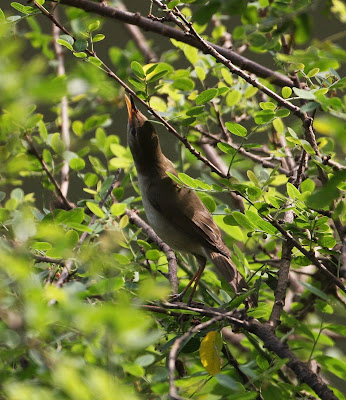Banana Posture?
The so-called 'banana posture', in which both the head and tail are held erect at angles to the body, has been suggested as useful in the ID of the species. There is no doubt the species does occasionally adopt this posture as shown in first photo below, but I am doubtful that it is useful in separating this species from Reed and Marsh Warbler, as these two species also occasionally adopt the same posture. I did not note the species to adopt this posture persistently - only sporadically. The species seems to adopt this posture just before hopping onto a branch or taking flight as shown in the second photo below - the same bird as in te first photo but taken two seconds later, and does not adopt it when stretching up to feed as has been suggested - shown in the third photo below.
The so-called 'banana posture', in which both the head and tail are held erect at angles to the body, has been suggested as useful in the ID of the species. There is no doubt the species does occasionally adopt this posture as shown in first photo below, but I am doubtful that it is useful in separating this species from Reed and Marsh Warbler, as these two species also occasionally adopt the same posture. I did not note the species to adopt this posture persistently - only sporadically. The species seems to adopt this posture just before hopping onto a branch or taking flight as shown in the second photo below - the same bird as in te first photo but taken two seconds later, and does not adopt it when stretching up to feed as has been suggested - shown in the third photo below.
As is the case in many species, I noted Blyth's Reed to be far more dynamic in it's movements just after first light, with the tail most likely to be cocked at this time. Birds seemed become much less energetic later in the morning and during the rest of the day. Therefore comparing the posture of a Blyth's Reed Warbler watched early morning, to a Reed Warbler watched mid-afternoon, may not be a fair comparison.The species also flicks it's tail at the same time at which it gives a 'tak', and sometimes dips it's tail downwards a short distance. It sometimes appears very phylloscopus-like and in particular Chiffchaff-like, while at other times can appear very elongated and Reed Warbler-like - see the collage of 2 photos below. It would be interesting to compare the behaviour of the species on migration, on breeding grounds and on wintering grounds, where the response to different stimuli could be different in each case.




Call
Every single Blyth's Reed Warbler seen in Goa, of which there were many, were found by their fairly loud 'tak' call. This suggests the species is very vocal, but there were perhaps an unquantified number of birds present which did not call, and which were not seen. The species sometimes interupts it's 'tak' call with a rolling typically type churr, a call often given by Reed Warbler.
Colouration
The tone of Blyth's Reed Warblers is said to be a supporting feature in identification, but great care is needed. The colour tone of any individual can change instantaneously, and depends on such factors as the intensity of sunlight, camera settings, shadows of leaves and intraspecfic plumage variation. Even after taking all of these factors into account, each observer could potentially interpret and then describe colours differently due to the subtleties involved. The collage of 4 photos below shows the variable colouration of the species.

Other ID Features
Other features I looked for included the extent of supercilium in front of the eye, the primary emarginations and primary projection. These are all useful in separating the species from Reed Warbler, but accurately interpreting them in the field is very difficult and possibly not of much use - either good quality photos or a bird in the hand is probably the only way of recording these features correctly.
1 comment:
If you cannot see this page properly, then please email.
Post a Comment